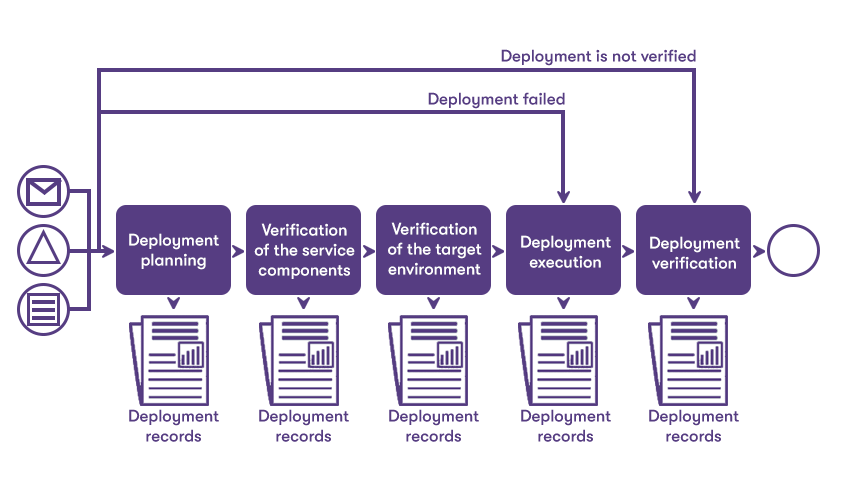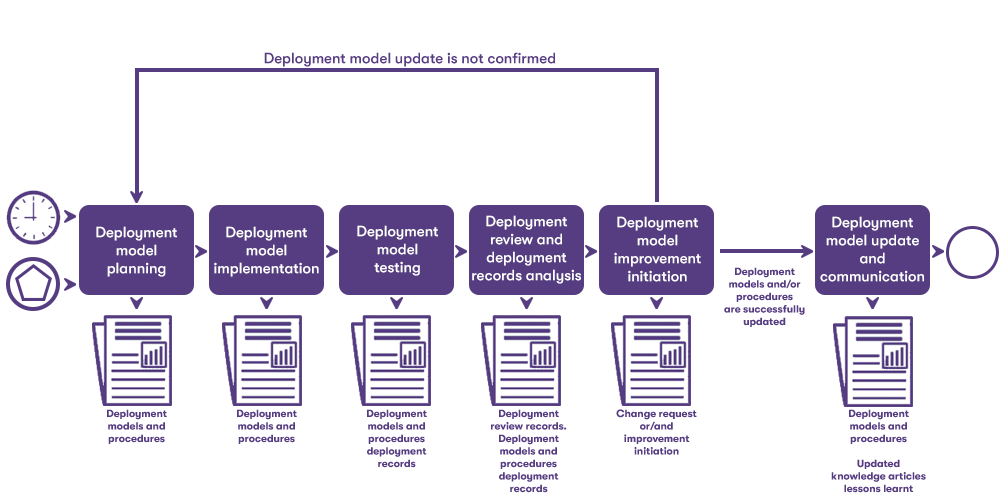ITIL defines Deployment Management as a process within IT Service Management (ITSM) that focuses on the planning, scheduling, and controlling of the movement of releases to the live environment. It ensures that IT services and infrastructure components are deployed effectively, efficiently, and reliably.
Deployment Management is responsible for coordinating the deployment of new or changed software, hardware, or infrastructure components into the production environment. It involves activities such as release packaging, testing, scheduling, communication, and coordination with various stakeholders.
ITIL® Deployment Management
Deployment Management is closely aligned with other ITIL practices, particularly Change Management and Release Management. It collaborates with Change Management to ensure that changes are planned and coordinated effectively.
By adopting the principles and activities of Deployment Management, organisations can achieve faster and more reliable deployment of services, reduced downtime, improved service quality, and increased customer satisfaction. It enables organisations to respond more effectively to changes and deliver value to customers in a controlled and efficient manner.
What is ITIL® Deployment Management?

ITIL deployment management is a crucial process within the ITIL framework. It focuses on planning, scheduling, and controlling the release of software and hardware into the live environment.
The goal is to ensure successful deployment with minimal disruption to business operations.
Key activities include deployment planning, building and configuration, deployment, communication and stakeholder management, and monitoring with feedback.
The objective of the deployment management practice is to transition new or modified hardware, software, documentation, processes, and other components into live environments. Additionally, it may encompass the deployment of components to other environments for testing or staging purposes.
What Is The Objective Of Deployment Management in ITIL?

Objectives of Deployment Management include:
Planning and coordinating the deployment activities
Planning and coordinating the deployment activities in deployment management contribute to several key aspects of IT service management:
Minimising disruption
Effective planning helps in identifying potential risks and dependencies, allowing organisations to minimise disruptions during the deployment. By coordinating activities and ensuring proper sequencing, deployment management reduces the impact on business operations and end users.
Efficient resource allocation
Planning enables the identification and allocation of the necessary resources, such as infrastructure, personnel, and tools, required for the deployment. Coordinating these resources ensures they are utilised effectively, preventing wastage and optimising cost.
Time management
Deployment management involves creating deployment plans with clear timelines and milestones. This contributes to efficient time management by defining specific activities, their sequencing, and estimated durations. Coordinating the deployment activities ensures that tasks are executed as scheduled, minimising delays and meeting the required timelines.
Risk mitigation
Planning and coordination help in identifying and addressing potential risks associated with the deployment. By conducting risk assessments, implementing preventive measures, and defining contingency plans, deployment management contributes to mitigating risks and ensuring smooth deployments.
Communication and stakeholder management
Planning and coordination involve establishing effective communication channels with stakeholders involved in the deployment. Regular updates, progress reports, and coordination meetings enable stakeholders to stay informed and aligned. This contributes to managing expectations, resolving issues promptly, and maintaining positive relationships with stakeholders.
Change management
Effective deployment planning and coordination align with the broader change management process. By coordinating the deployment activities with change management, deployment management ensures that changes are properly authorised, assessed, and scheduled. This integration minimises risks and ensures that the overall change process is consistent and controlled.
Minimising risks and disruptions
This objective contributes to the overall success and stability of the IT services by addressing potential risks and disruptions in the deployment process. Here are some ways in which minimising risks and disruptions contributes to effective deployment management:
Risk identification and assessment
The deployment management process involves identifying and assessing potential risks associated with the deployment. This includes analysing the impact of the deployment on the existing IT infrastructure, applications, and services. By thoroughly identifying and assessing risks, organisations can proactively plan and implement measures to mitigate them, reducing the likelihood of disruptions.
Risk mitigation strategies
Minimising risks and disruptions requires the development and implementation of risk mitigation strategies. This involves defining appropriate controls, contingency plans, and fallback procedures to handle potential issues during the deployment. By having well-defined mitigation strategies in place, deployment management helps reduce the impact of risks and disruptions, ensuring a smoother transition.
Testing and validation
Prior to deployment, rigorous testing and validation processes are conducted to ensure that the new or changed IT services function as intended. This includes various types of testing, such as functional, performance, and user acceptance testing. By conducting thorough testing, organisations can identify and address potential issues before the deployment, reducing the likelihood of disruptions in the live environment.
Change evaluation and impact assessment
As part of the deployment management process, the impact of the changes introduced through the deployment is evaluated. This includes assessing the potential impact on users, processes, and infrastructure. By evaluating the impact, organisations can take necessary measures to minimise disruptions and ensure that the changes are aligned with business objectives.
Communication and coordination
Minimising risks and disruptions requires effective communication and coordination among stakeholders involved in the deployment. This includes providing clear instructions, updates, and guidelines to those responsible for executing the deployment activities. By promoting open and transparent communication, deployment management enables stakeholders to collaborate effectively, identify potential risks, and address them promptly, minimising disruptions.
Continual improvement
Deployment management contributes to the continual improvement of the deployment process by analysing and learning from past deployments. By capturing and analysing data related to risks, disruptions, and lessons learned, organisations can refine their deployment strategies and implement improvements in subsequent deployments. This iterative approach helps minimise risks and disruptions over time.
Efficient release packaging and build management
This objective contributes to the efficiency and effectiveness of the deployment process. Here are some ways in which release packaging and build management contribute to effective deployment management:
Standardised release packaging
Deployment management emphasises the need for standardised release packaging practices. This involves defining consistent packaging standards, formats, and structures for software, configurations, and other components that make up the release. By following standardised packaging practices, organisations ensure that releases are consistent, manageable, and easily deployable, reducing the potential for errors and disruptions.
Configuration management
Release packaging and build management integrate with configuration management practices. By accurately identifying and documenting the configuration items (CIs) that make up the release, deployment management ensures that the correct components are packaged together. This promotes consistency and enables efficient tracking and management of the configuration items during deployment.
Build management
Effective build management is crucial for ensuring that the release components are built correctly and reliably. This involves establishing build processes, tools, and environments that facilitate the compilation, integration, and testing of software and configurations. By implementing robust build management practices, deployment management ensures that the built releases are of high quality and ready for deployment.
Release version control
Deployment management includes managing and controlling different versions of releases. This involves establishing version control mechanisms, such as version numbering and repository management, to keep track of changes and ensure that the correct versions are deployed. By maintaining version control, deployment management reduces the risk of deploying outdated or incorrect releases, minimising disruptions and errors.
Testing and validation
Release packaging and build management contribute to the testing and validation processes before deployment. By ensuring that the built releases undergo thorough testing, including functional, performance, and compatibility testing, deployment management minimises the risk of deploying flawed or unreliable releases. This promotes the delivery of high-quality IT services to the live environment.
Documentation and knowledge management
As part of release packaging and build management, documentation plays a critical role. Deployment management ensures that the necessary documentation, such as release notes, installation guides, and configuration instructions, is created and maintained. This documentation facilitates efficient deployment and supports knowledge management, enabling consistent and accurate deployments in the future.
Communication and coordination
This objective contributes to the successful implementation of new or changed IT services by fostering collaboration, alignment, and shared understanding. Here are some ways in which communication and coordination contribute to effective deployment management:
Stakeholder engagement
Effective communication and coordination ensure that all relevant stakeholders are engaged and informed throughout the deployment process. This includes IT teams, business units, service owners, end users, and other key stakeholders. By engaging stakeholders and keeping them informed about the deployment activities, progress, and potential impacts, deployment management builds trust, manages expectations, and promotes stakeholder buy-in.
Clear communication channels
Deployment management establishes clear communication channels and mechanisms to facilitate timely and accurate information exchange. This includes regular status updates, deployment plans, coordination meetings, and progress reports. By providing clear and consistent communication, deployment management enables stakeholders to stay informed, raise concerns, and provide feedback, fostering effective collaboration.
Risk and issue management
Communication and coordination are essential for identifying, assessing, and addressing risks and issues that may arise during the deployment. By establishing open lines of communication, deployment management allows stakeholders to report risks and issues promptly. This enables timely mitigation actions, resolution of issues, and minimisation of potential disruptions.
Change management alignment
Effective communication and coordination with the change management process contribute to successful deployment. Deployment management ensures that changes introduced through the deployment are aligned with the overall change management strategy and plans. By coordinating deployment activities with change management, deployment management ensures that changes are properly authorised, assessed, and scheduled, minimising risks and disruptions.
Collaboration among teams
Deployment management facilitates collaboration among different teams involved in the deployment process. This includes coordination between development, operations, testing, and other IT teams. By fostering collaboration and shared understanding, deployment management promotes efficient knowledge sharing, efficient handovers, and effective problem-solving during the deployment.
Training and awareness
Communication and coordination play a crucial role in training and creating awareness among end users and support teams regarding the new or changed IT services. Deployment management ensures that relevant training materials, user guides, and support documentation are effectively communicated to stakeholders. This promotes user adoption, minimises user errors, and enables efficient support and troubleshooting.
Continual improvement
This objective contributes to the overall effectiveness, efficiency, and value of the deployment management activities. Here are some ways in which continual improvement contributes to effective deployment management:
Learning from past deployments
Continual improvement in deployment management involves analysing and learning from past deployments. By capturing data and feedback related to previous deployments, organisations can identify areas for improvement, lessons learned, and success factors. This knowledge informs future deployments and helps refine deployment strategies, processes, and practices.
Process refinement
Continual improvement involves regularly reviewing and refining the deployment management processes. This includes assessing the effectiveness and efficiency of the deployment activities, identifying bottlenecks, and streamlining the processes. By continuously optimising the deployment management processes, organisations can achieve higher levels of productivity, minimise errors, and reduce the time and effort required for deployments.
Measurement and metrics
Continual improvement in deployment management requires establishing measurement and metrics frameworks to assess the performance and outcomes of the deployments. This includes tracking key performance indicators (KPIs) related to deployment success, such as deployment success rate, time to deploy, and customer satisfaction. By measuring and analysing these metrics, organisations can identify areas of improvement and make data-driven decisions to enhance the deployment process.
Feedback and collaboration
Continual improvement encourages feedback and collaboration among stakeholders involved in the deployment process. This includes gathering feedback from IT teams, end users, and other stakeholders on their experiences and suggestions for improvement. By fostering a culture of collaboration and actively seeking feedback, deployment management can identify areas of improvement, address issues, and incorporate valuable insights into future deployments.
Automation and tooling
Continual improvement promotes the adoption of automation and appropriate tools to streamline the deployment process. By leveraging automation and tools for tasks such as release packaging, configuration management, and deployment orchestration, organisations can enhance efficiency, reduce manual errors, and improve the consistency and reliability of deployments. Continual improvement encourages organisations to assess and adopt new technologies and tools that can optimise the deployment management activities.
Feedback loop with other ITIL practices
Continual improvement in deployment management involves establishing feedback loops with other ITIL practices, such as change management, and release management. This ensures that insights, lessons learned, and improvements from deployment activities are shared and integrated across the IT service lifecycle. By maintaining alignment and feedback loops with other practices, deployment management can contribute to the overall improvement of the IT service management processes.
What Deployment Techniques Are Used for Management?
In ITIL deployment management, various deployment techniques are utilised to ensure the successful transition of new or changed components into the live environment. These techniques are employed to minimise disruptions, mitigate risks, and maintain the stability and integrity of IT services. Here are some commonly used deployment techniques:
Big Bang Deployment
This technique involves deploying all components of a release simultaneously. It is typically used when the impact of the release is minimal, and the risk of disruption is low. It requires thorough testing and coordination to ensure a smooth transition.
Phased Deployment
Phased deployment involves rolling out a release in stages or phases. It allows for gradual implementation and reduces the overall risk by addressing issues in a controlled manner. Each phase is tested and validated before moving to the next, providing an opportunity to learn and adjust as deployment progresses.
Parallel Deployment
In this technique, the new release is deployed alongside the existing version in a parallel environment. Both versions run simultaneously, allowing for a comparison and verification of the new release's performance and functionality before fully transitioning to the new environment.
Pilot Deployment
A pilot deployment involves releasing the new or changed components to a smaller, selected group of users or within a specific location or department. This technique allows for real-world testing and feedback from a limited user base, enabling the identification and resolution of issues before a full-scale deployment.
Rolling Deployment
Rolling deployment involves gradually transitioning the new release across different areas or user groups while maintaining the availability of the existing version. This technique minimises disruption by allowing users to switch to the new release in a controlled and incremental manner.
Automated Deployment
Automation plays a crucial role in deployment management. It involves using automation tools and scripts to streamline and expedite deployment processes, reducing manual errors and improving efficiency. Automated deployment techniques often include continuous integration/continuous deployment (CI/CD) pipelines and configuration management tools.
The choice of deployment technique depends on factors such as the complexity of the release, the impact on users and services, risk tolerance, and available resources. A careful assessment of these factors helps determine the most appropriate deployment technique for a specific release. Additionally, effective planning, testing, and coordination are essential to ensure a smooth deployment and minimise any potential negative impact on the organisation and its users.
What Are the Best Practices for Managing Deployment?

ITIL provides a set of best practices for deployment management, which are designed to facilitate effective and efficient deployment of IT changes. Here are some key ITIL4 practices that integrate with and help support effective deployment management:
Release Planning and Management
Adopt a structured approach to release planning, including creating a detailed release schedule, defining release packages and units, and considering dependencies and risks. Implement change and release management processes to ensure proper coordination and control of releases.
Testing and Validation
Establish comprehensive testing processes to validate the functionality, performance, and stability of releases. This includes various testing stages such as unit testing, integration testing, system testing, and user acceptance testing. Use test environments that closely resemble the live environment to ensure accurate results.
Configuration Management
Implement a robust configuration management process to maintain accurate and up-to-date information about the configuration items (CIs) and their relationships. This helps ensure that only authorised and tested releases are deployed into the live environment.
Release Packaging and Deployment
Package releases in a consistent and standardised manner to enable efficient deployment. Clearly document the contents of release packages, including software builds, hardware configurations, and associated documentation. Follow a structured deployment process that includes proper scheduling, coordination, and rollback plans.
Change Control and Communication
Integrate deployment management with change management processes to ensure proper authorisation, impact assessment, and coordination of changes. Establish effective communication channels with stakeholders, providing clear and timely updates on release schedules, impacts, and instructions.
Release Evaluation and Continuous Improvement
Conduct post-deployment evaluations to assess the effectiveness of the release and identify areas for improvement. Gather feedback from users and stakeholders and incorporate it into future release planning and deployment activities. Continuously improve the deployment management process based on lessons learned and feedback.
Automation and Tooling
Leverage automation tools and technology to streamline deployment processes, improve efficiency, and reduce manual errors. Implement a centralised release management tool that provides visibility, control, and reporting capabilities throughout the release lifecycle.
By following these ITIL best practices, organisations can enhance the success rate of their deployments, minimise disruptions, improve service quality, and achieve better alignment between IT and business objectives.
What is the Deployment Management Process?
The ITIL 4 Deployment Management process is a set of activities and steps that organisations follow to plan, coordinate, and execute the release and deployment of new or changed services into the production environment. It ensures that the deployment is carried out in a controlled and efficient manner, minimising risks and disruptions to the business and maximising value realisation.
Deployment Management Process

Deployment planning
Upon receiving a trigger for deployment, typically through procurement or the change request initiator, the service provider will arrange a comprehensive deployment plan. This plan will be coordinated to harmonise with the priorities of the impacted teams and their available resources.
Verification of the service components
Upon completing the plan, the service provider checks the competence of all assets, including:
- Inventory
- Documentation
- Quality checks
- Suitable test has been carried out
Verification of the target environments
The product/service is prepped for installation at its desired location/environment. The aim in installation is to cause as minimal disruption to service users. All elements of the installation should be significantly prepared with relevant back-ups if needed.
Deployment execution
Either the service provider or external supplier personnel will carry out the installation and activation of the equipment in accordance with the provided installation instructions, which may involve performing periodic checks. Alternatively, if the software's target environment is automated, so minimal human involvement is required.
Deployment verification
After the product or service has been installed a series of test should be performed to confirm that it is delivering the desired outcome. Upon the conclusion of testing, the change requestor, such as a product owner, will be notified of the completion of the deployment.
The primary objective of this process is to consistently enhance the practice of deployment management, including deployment models and procedures. It is carried out on a regular basis or triggered by deployment failures that reveal areas of inefficiency and opportunities for improvement. Routine assessments may take place every three months or with increased frequency, depending on the effectiveness of the current models and procedures.
Deployment management activities workflow

Deployment model planning
In cases where a product adheres to a comparable deployment pattern with low risk and high success rate, and there are opportunities to minimize waste and shorten deployment lead times, the deployment manager has the option to establish a fresh deployment model. The objective of this deployment model is to diminish human involvement and exert control over the deployment process.
Deployment model implementation
The deployment manager takes responsibility for arranging the necessary configuration of pipeline tools to facilitate the new deployment model. This includes setting up access settings, code support, and branching procedures as required. In cases where automated deployment tools are not applicable, the deployment manager establishes clear guidelines and effectively communicates them to the teams and involved parties.
Deployment model testing
The deployment manager conducts thorough testing of the new deployment model to verify its ability to handle edge cases and workflow effectively. In situations where testing is not feasible, the deployment manager supervises the initial live runs of the model.
Deployments review and deployment failure records analysis
The deployment manager collaborates with service owners and other pertinent stakeholders to conduct a review of specific deployments or deployment failures. This review aims to identify potential areas for optimizing deployment models and procedures.
Deployment model improvement initiation
The deployment manager documents the improvement initiatives to be addressed, involving the continual improvement practice for further processing. Alternatively, if the deployment models and procedures fall within the realm of change enablement, the deployment manager initiates a change request.
Deployment model update and communication
Once the deployment model is successfully updated, the pertinent stakeholders are informed accordingly. Typically, this communication is carried out by either the deployment manager, the service owner, or the resource owner.
What Is The Difference Between Release And Deployment Management?

In ITIL 4, there is a difference between release management and deployment management. Let's explore each one:
ITIL 4 Release Management
Release management in ITIL 4 focuses on the planning, coordination, and governance of the overall release of services and service components. It involves managing the transition of new or changed services and ensuring that they are successfully delivered into the live environment. Release management encompasses the entire lifecycle of a release, from initial planning and design to overseeing testing, deployment, and evaluation. It aims to maximise the value of releases while minimising disruption and risk.
Key aspects of ITIL 4 Release Management include:
- Planning and coordination of releases.
- Communication and stakeholder management.
- Managing the release pipeline and release packages.
- Defining and enforcing release policies and standards.
- Assessing and managing risks associated with releases.
- Evaluation and continuous improvement of release processes.
ITIL 4 Deployment Management
Deployment management, on the other hand focuses on the implementation and movement of new or changed hardware, software, applications, or infrastructure components into the live environment. Deployment management is responsible for executing the planned deployment activities, ensuring that the right components are installed, configured, and integrated correctly.
Key aspects of ITIL 4 Deployment Management include:
- Execution of deployment plans and activities.
- Verification and validation of release components during deployment.
- Coordinating with various stakeholders for successful deployment.
- Ensuring proper documentation and tracking of deployment activities.
- Monitoring and reporting on the success of deployments.
In summary, ITIL 4 release management focuses on the overall planning and governance of releases, including strategic decisions and coordination, while deployment management specifically deals with the execution and implementation of releases into the live environment. Deployment management is a separate process but often seen as a subset of release management, focusing on the technical aspects of transitioning new or changed components into production.
Where Can You Learn More?
Currently PeopleCert is developing practitioner courses which cover each of the 34 practices within ITIL4. So, keep your eye out for the deployment management practitioner course, or sign-up to our newsletter to get notified when it is released!
Currently there are a few options to learn about ITIL® 4 Deployment Management:
ITIL® 4 Foundation
In the ITIL 4 Foundation course, the topic of deployment management is introduced as part of the broader understanding of the ITIL service lifecycle and its various stages. While the depth of coverage may not be as extensive as in specialised courses, the foundation level provides a high-level overview of deployment management and its role within the ITIL framework.
ITIL® 4 Specialist: Create, Deliver and Support (CDS)
This course focuses on the practical aspects of creating, delivering, and supporting IT services. It covers topics such as service design, service transition, deployment management, service validation and testing, and release management. Deployment management is specifically addressed within the context of service transition and release management processes.
ITIL 4 Strategist: Direct, Plan and Improve (DPI)
The DPI course provides guidance on developing an organisation's IT strategy and aligning it with business objectives. It covers topics such as governance, risk management, organisational change management, and continual improvement. Although deployment management is not the primary focus of this course, it provides a broader understanding of strategic planning and improvement, which indirectly influences deployment management activities.
Final Notes on Deployment Management and ITIL
ITIL 4 deployment management focuses on planning, coordinating, and minimising risks in the deployment of new or changed IT services. It involves activities such as release packaging, build management, verification and validation, and communication and coordination. The objective is to ensure smooth deployments, minimise disruptions, and achieve successful implementation. Continual improvement is emphasised, enabling organisations to learn from past deployments, refine processes, gather feedback, and enhance efficiency. By following ITIL 4 deployment management practices, organisations can deliver high-quality IT services, reduce risks, and align deployments with business objectives, ultimately enhancing customer satisfaction and driving business success.


